Converting temperatures between Fahrenheit and Celsius is essential for various applications, including cooking, science, and travel. This guide provides a detailed Fahrenheit to Celsius chart PDF, offering a quick reference for accurate conversions. The formula F = (C × 9/5) + 32 simplifies the process, while the chart ensures ease of use without complex calculations. Perfect for everyday tasks or professional needs, this resource is indispensable for anyone requiring precise temperature conversions.
Importance of Understanding Temperature Conversion
Understanding how to convert temperatures between Fahrenheit and Celsius is crucial for accuracy in various fields. Whether for cooking, scientific research, or travel, precise temperature readings are essential. A Fahrenheit to Celsius chart PDF provides a reliable reference, eliminating calculation errors and saving time. It ensures consistency across different applications, making it indispensable for both professionals and everyday use. This tool is particularly valuable for comparing temperature scales accurately and efficiently.
Overview of the Fahrenheit and Celsius Scales
The Fahrenheit and Celsius scales are two widely used temperature measurement systems. The Celsius scale, developed by Anders Celsius, sets water’s freezing point at 0°C and boiling point at 100°C. In contrast, the Fahrenheit scale, created by Gabriel Fahrenheit, assigns water’s freezing point at 32°F and boiling point at 212°F. Both scales are linear, with each degree representing equal temperature intervals. Understanding their differences is key for accurate conversions, especially when using a Fahrenheit to Celsius chart PDF for quick reference.
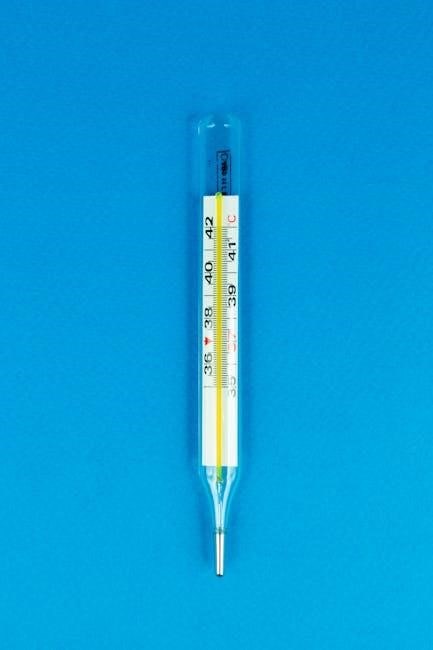
How to Convert Fahrenheit to Celsius
To convert Fahrenheit to Celsius, use the formula: C = (F ⎯ 32) × 5/9. This method ensures accurate temperature conversions for any value. For quick reference, a Fahrenheit to Celsius chart PDF provides pre-calculated values, saving time and effort. Both approaches are reliable for personal or professional use, ensuring precise temperature conversions across various applications.
The Mathematical Formula for Conversion
The formula to convert Fahrenheit to Celsius is C = (F ─ 32) × 5/9. This equation allows precise temperature conversion by first subtracting 32 from the Fahrenheit value, then multiplying the result by 5/9. For example, converting 50°F involves calculating (50 ⎯ 32) × 5/9 = 10°C. This mathematical approach ensures accuracy and is widely used in scientific, culinary, and engineering applications; It also serves as the foundation for creating Fahrenheit to Celsius charts, providing a reliable method for quick reference.
Step-by-Step Guide to Manual Conversion
To manually convert Fahrenheit to Celsius, follow these steps:
Subtract 32 from the Fahrenheit temperature:
Fahrenheit ⎯ 32.
Multiply the result by 5/9:
(Fahrenheit ─ 32) × 5/9 = Celsius.
For example, to convert 50°F to Celsius:
50 ⎯ 32 = 18
18 × 5/9 = 10°C.
This method ensures accurate conversions without relying on charts or calculators. Practice with various temperatures to master the process.
Common Conversion Errors and How to Avoid Them
Common errors in Fahrenheit to Celsius conversions often stem from formula misuse or calculation mistakes. A frequent mistake is forgetting to subtract 32 before multiplying by 5/9. Another error is reversing the formula steps, leading to incorrect results. To avoid these, always follow the sequence: subtract 32, then multiply by 5/9. Double-checking calculations and using a reference chart can help ensure accuracy. Regular practice minimizes errors and enhances conversion proficiency.

Fahrenheit to Celsius Chart: Structure and Usage
A Fahrenheit to Celsius chart is a reference tool displaying corresponding temperatures in both scales. It typically features three columns: Fahrenheit, Celsius, and their equivalents. The chart follows the formula (°C = (°F ─ 32) × 5/9}, providing a clear, organized layout for easy conversions. Temperatures often range from -40°F to 212°F, covering common and extreme values. Key points like water freezing (32°F/0°C) and boiling (212°F/100°C) are highlighted for quick reference, ensuring accuracy and ease of use.
Understanding the Chart Layout
The Fahrenheit to Celsius chart is structured for easy readability, typically divided into three columns: Fahrenheit, Celsius, and sometimes a middle column for quick alignment. Each row pairs a specific Fahrenheit temperature with its Celsius equivalent, calculated using the formula (°C = (°F ⎯ 32) × 5/9}. The chart often includes key reference points such as the freezing and boiling points of water, 32°F/0°C and 212°F/100°C, respectively. Temperatures are usually listed in ascending order, making it simple to locate and convert any given temperature quickly. This organized layout ensures users can find the information they need without confusion, making it an invaluable tool for both everyday and professional use.
How to Read and Interpret the Chart
To use the Fahrenheit to Celsius chart, align the known temperature in the appropriate column (F or C) and read the corresponding value in the other column. For example, if you have 50°F, locate it in the Fahrenheit column and find the matching Celsius value, which is 10°C. The chart is structured with clear columns and rows, making it easy to navigate. Simply match the temperature scale you have to the one you need, ensuring accurate and quick conversions for any application, from cooking to scientific research.
Key Temperature Points in the Chart
The Fahrenheit to Celsius chart highlights critical temperature points, such as the freezing and boiling points of water. At 32°F, water freezes, equivalent to 0°C, and at 212°F, it boils, matching 100°C. Other notable points include human body temperature (98.6°F or 37°C) and common temperatures like 50°F (10°C) and 70°F (21.1°C). These key points serve as reference markers, ensuring accurate and reliable conversions for various practical and scientific applications, making the chart an essential tool for quick temperature comparisons.
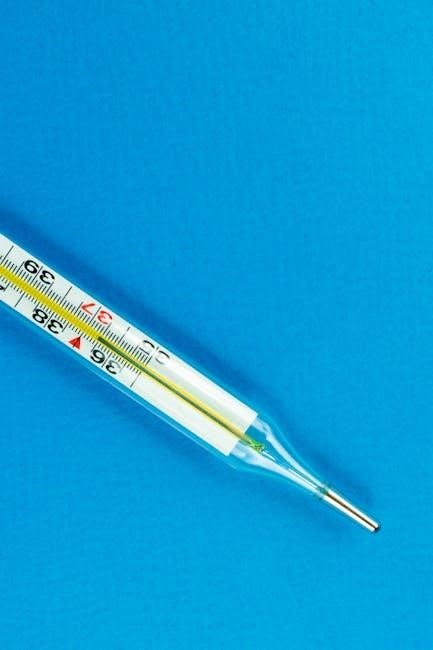
Applications of the Fahrenheit to Celsius Chart
The Fahrenheit to Celsius chart is widely used in cooking, scientific research, and travel. It aids in converting recipes, scientific data, and weather forecasts, ensuring accuracy and efficiency in diverse fields, making it an indispensable tool for everyday and professional tasks.
Everyday Use Cases for the Chart
The Fahrenheit to Celsius chart is invaluable for everyday tasks, such as cooking, travel, and weather monitoring. It simplifies recipe conversions, allowing home cooks to adjust temperatures seamlessly. Travelers benefit by understanding foreign weather forecasts, while the chart also aids in converting household thermostat settings. Its user-friendly format ensures quick access to accurate temperature equivalents, making it a must-have tool for daily life and international communication.
Importance in Scientific and Cooking Recipes
Accurate temperature conversion is crucial in both scientific research and cooking. In science, precise measurements are essential for experiments and data analysis. For cooking, converting between Fahrenheit and Celsius ensures recipes are followed correctly, especially for techniques like baking or candy-making, where temperature control is critical. The Fahrenheit to Celsius chart provides a reliable reference, preventing errors and ensuring consistent results in laboratories and kitchens alike.
Travel and Weather-Related Applications
When traveling internationally, understanding temperature differences is essential, as many countries use Celsius; A Fahrenheit to Celsius chart helps travelers interpret weather forecasts, ensuring they pack appropriately and stay comfortable. Additionally, it aids in understanding climate conditions, making it invaluable for outdoor activities like hiking or skiing. This tool bridges the gap between regions with different temperature scales, enhancing travel experiences and practical decision-making.
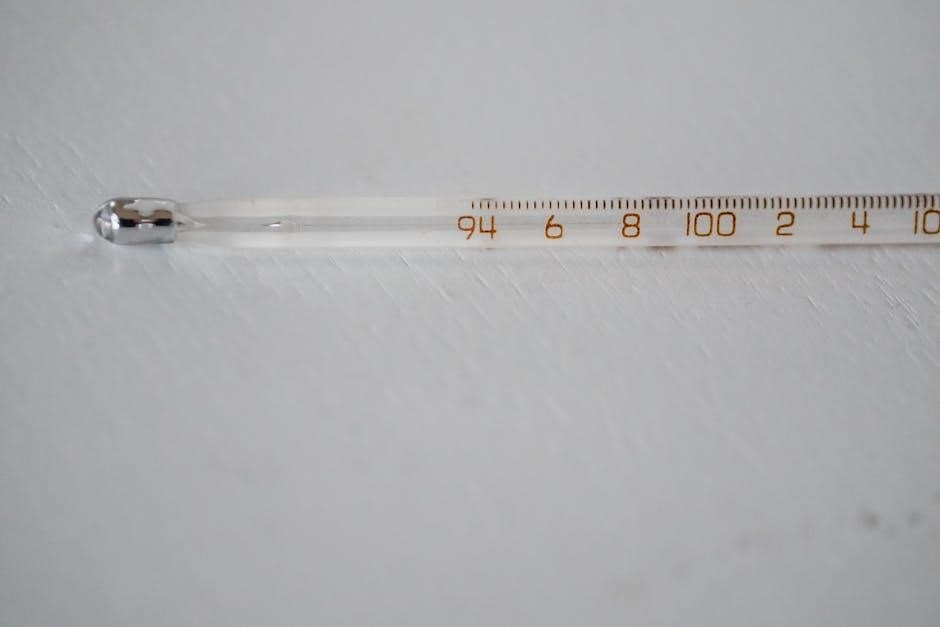
Downloading and Using the PDF Chart
The Fahrenheit to Celsius chart PDF is easily downloadable from reputable websites like Metric Conversions. Print it for quick access or customize it to suit specific needs, ensuring convenience in temperature conversions.
Steps to Download the Fahrenheit to Celsius Chart PDF
Downloading the Fahrenheit to Celsius chart PDF is straightforward. Visit a reliable website like Metric Conversions or Handypdf.com. Locate the download button, typically labeled “Download PDF” or “Printable Chart.” Click the link to save the file to your device. Ensure the chart includes a wide temperature range for versatility. Some sites offer customizable options, allowing you to tailor the chart to specific needs. Once downloaded, print it for easy access or store it digitally for future reference.
Printing and Storing the Chart for Easy Access
Print the Fahrenheit to Celsius chart PDF on high-quality paper for clear readability. Use a standard printer setting to maintain the chart’s layout. Consider laminating the chart to protect it from wear and tear. Store it in a frequently accessed location, such as the kitchen for cooking or a study area for homework. For digital convenience, save the PDF in a dedicated folder on your device or cloud storage, ensuring quick retrieval whenever needed. This ensures the chart remains easily accessible for various tasks.
Customizing the Chart for Specific Needs
Customize the Fahrenheit to Celsius chart PDF to suit your requirements. Highlight specific temperature ranges for quick reference, such as common cooking temperatures. Add notes or annotations for frequently used conversions. Use editing tools to resize or reorder columns for better readability. For digital versions, copy and paste relevant sections into personal documents or spreadsheets. This personalization ensures the chart aligns with your specific needs, enhancing efficiency in tasks like recipe adjustments or scientific calculations.
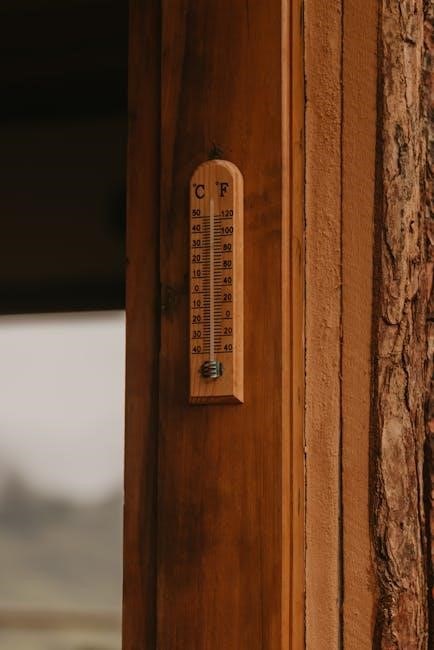
Online Tools and Resources
Utilize online tools like conversion calculators and downloadable Fahrenheit to Celsius chart PDFs for quick and accurate temperature conversions. Websites such as Metric Conversions and ConversionCalculator.org offer reliable resources, including interactive charts and formulas. These tools simplify the process, allowing users to convert temperatures instantly or print charts for offline use.
Using Online Converters for Quick Conversions
Online converters simplify temperature conversions, offering instant results without manual calculations. Websites like ConversionCalculator.org and Metric Conversions provide user-friendly tools. Enter the temperature in one scale, and the converter automatically calculates the equivalent in the other. These tools are ideal for quick lookups and feature formulas like F = (C × 9/5) + 32 for Fahrenheit to Celsius. They also often include charts and tables for reference, making them versatile for various needs, from cooking to scientific applications.
Recommended Websites for Reliable Conversion Data
For accurate temperature conversions, visit trusted websites like ConversionCalculator.org or Metric Conversions. These sites offer reliable Fahrenheit to Celsius charts and formulas. They provide downloadable PDF charts, online calculators, and step-by-step guides. Additional resources include interactive tools and formulas like F = (C × 9/5) + 32. These platforms are ideal for quick, precise conversions, catering to both casual and professional needs, ensuring accuracy and ease of use for all users.
Interactive Charts and Their Benefits
Interactive temperature charts offer dynamic conversion experiences, allowing users to input specific values and receive instant results. These tools enhance learning by providing visual representations of temperature scales. They are ideal for educational purposes and quick reference, making conversions more engaging and accessible. Interactive charts also reduce errors by automating calculations, ensuring accuracy for both Fahrenheit to Celsius and Celsius to Fahrenheit conversions. Their versatility makes them a valuable resource for students, professionals, and enthusiasts alike.
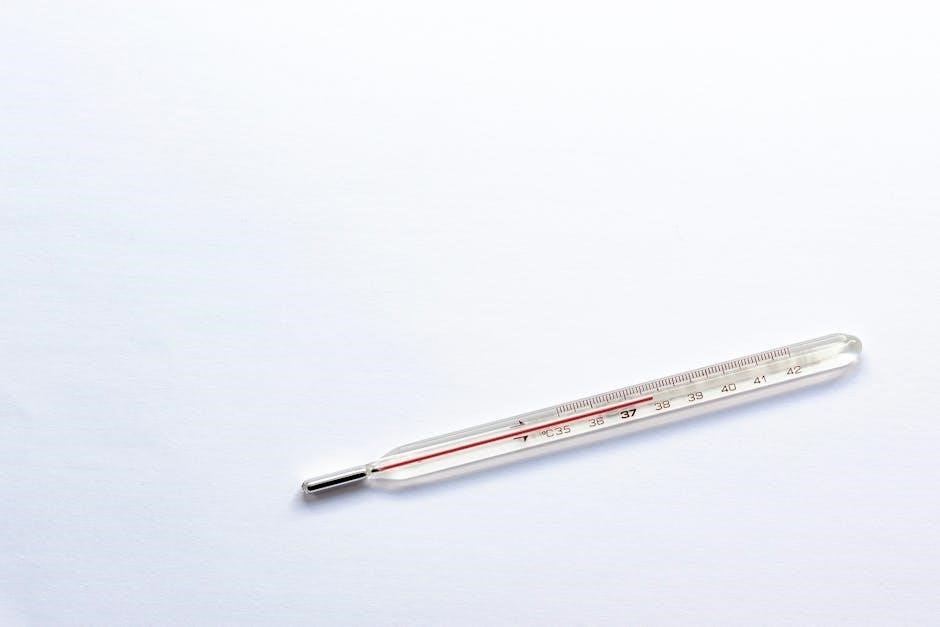
Historical Context of Temperature Scales
The Fahrenheit scale was created by Gabriel Fahrenheit in 1724, while Anders Celsius introduced the Celsius scale in 1742, establishing the basis for modern temperature measurement.
The Origins of the Fahrenheit Scale
The Fahrenheit scale was developed by German physicist Gabriel Fahrenheit in 1724. He established 32°F as the freezing point of water and 212°F as the boiling point, creating a 180-degree interval between these points. Fahrenheit’s scale was widely used in scientific and everyday applications, especially in the United States, until the Celsius scale gained prominence. Its legacy remains in weather forecasts and cooking in some countries, making Fahrenheit-to-Celsius conversion charts essential for modern use.
The Development of the Celsius Scale
The Celsius scale was introduced by Swedish astronomer Anders Celsius in 1742. Initially, he inverted the scale, setting water’s freezing point at 100° and boiling point at 0°. After his death, Carl Linnaeus flipped the scale, establishing the modern range of 0°C for freezing and 100°C for boiling. This change made it intuitive and widely adopted in scientific communities. Today, the Celsius scale is the global standard for scientific and most everyday applications, complementing Fahrenheit in specific regions.
Evolution of Temperature Measurement Tools
Temperature measurement tools have evolved significantly, from early mercury thermometers to digital sensors. The invention of precision thermometers in the 18th century enabled accurate Fahrenheit and Celsius readings. Modern devices now offer instant conversions, reducing reliance on charts. Digital thermometers and smartphone apps provide precise, real-time data, making temperature conversion more accessible than ever. These advancements have streamlined processes in science, cooking, and weather forecasting, ensuring accuracy and efficiency in temperature monitoring and conversion tasks worldwide.
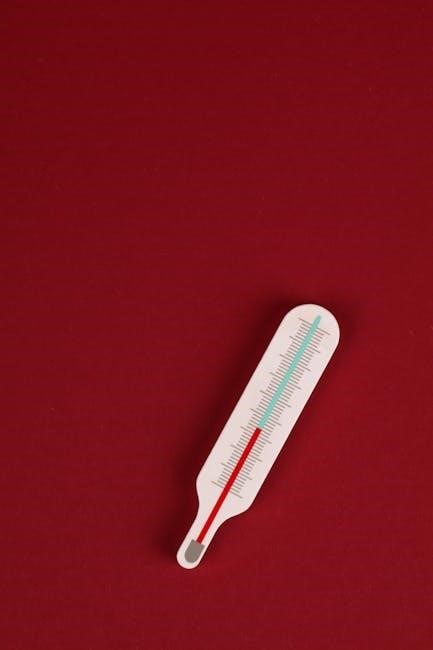
Printable Fahrenheit to Celsius Charts
Printable charts provide a convenient way to convert temperatures offline. Downloadable PDFs offer clear layouts, comprehensive temperature ranges, and easy-to-read formats. Ideal for quick reference in cooking, science, or everyday use, these charts ensure accuracy and accessibility without digital tools. Simply print and laminate for durable, long-term use, making temperature conversion straightforward and efficient for any purpose.
Benefits of Using Printable Charts
Printable Fahrenheit to Celsius charts offer numerous advantages. They provide offline accessibility, eliminating the need for internet connectivity. The charts are visually organized, making temperature conversion quick and error-free. Key benefits include comprehensive temperature ranges, clear formatting, and portability. Users can laminate them for durability, ensuring long-term use. These charts are ideal for educational settings, laboratories, and home use, serving as a reliable resource for accurate conversions. They save time and reduce reliance on digital tools, making them a practical solution for everyday needs.
How to Create Your Own Printable Chart
To create a Fahrenheit to Celsius printable chart, start by selecting a temperature range and intervals. Use spreadsheet software like Excel to generate pairs of Fahrenheit and Celsius values using the formula C = (F ⎯ 32) × 5/9. Design the layout with clear columns and rows for readability. Include headers and gridlines for easy navigation. Add conversion formulas at the top for reference. Customize fonts and colors for better visibility. Finally, save as a PDF and print on sturdy paper for long-term use.
Popular Formats for Printable Charts
Printable Fahrenheit to Celsius charts are widely available in PDF, DOCX, and image formats like PNG or JPG. PDF is the most popular due to its universal compatibility and high-quality printing. Charts are often designed in A4 or Letter sizes for standard printers. Many feature multiple columns, temperature ranges (-40°C to 100°C), and clear fonts for readability. Portrait orientation is common, though landscape layouts accommodate wider temperature spans. Ensure grids and headers are visible for easy navigation and accurate conversions.

Temperature Conversion in Various Fields
Temperature conversion is vital in cooking, science, engineering, and manufacturing. A Fahrenheit to Celsius chart PDF ensures accuracy across these fields, saving time and reducing errors.
Conversion in Cooking and Baking
Accurate temperature conversion is critical in cooking and baking, as small variations can affect results. A Fahrenheit to Celsius chart PDF is indispensable for recipes, ensuring precise measurements. For instance, 350°F (common for baking) equals 175°C. Chefs and home cooks rely on these charts to adapt international recipes, especially when units differ. Whether converting oven temperatures or ingredient specifications, a quick reference chart prevents errors and ensures consistency in culinary creations.
Conversion in Scientific Research
In scientific research, precise temperature measurements are crucial for accurate data and reproducibility. A Fahrenheit to Celsius chart PDF is a valuable tool for converting data in experiments and studies. Researchers often use this chart to ensure consistency, especially when collaborating with international teams or referencing foreign studies. The formula C = (F ─ 32) × 5/9 is frequently applied, but a chart provides a quick, error-free alternative, enhancing efficiency in laboratory settings and data analysis.

Conversion in Engineering and Manufacturing
In engineering and manufacturing, accurate temperature conversion is critical for material specifications and process control. A Fahrenheit to Celsius chart PDF is widely used to ensure precision in design and production. From metal melting points to electronic component specifications, this resource aids in maintaining consistency across international standards. The formula C = (F ─ 32) × 5/9 is essential, but the chart offers a quick reference, minimizing errors and enhancing operational efficiency in industrial applications.
The Fahrenheit to Celsius chart PDF is an invaluable resource for quick, precise conversions, making it essential for everyday use, professional applications, and international standards alignment.
The Fahrenheit to Celsius chart PDF provides a quick reference guide for temperature conversions, utilizing the formula F = (C × 9/5) + 32. It includes a comprehensive range of temperatures, making it ideal for everyday use, cooking, and scientific applications. The chart offers precise conversions, eliminating the need for complex calculations; Its user-friendly layout ensures easy readability, making it a valuable tool for both professionals and individuals needing accurate temperature conversion data.
Final Tips for Effective Temperature Conversion
For accurate temperature conversions, always use reliable tools like the Fahrenheit to Celsius chart PDF. Double-check formulas when performing manual calculations. Understand key reference points, such as water freezing at 0°C (32°F) and boiling at 100°C (212°F). Store the chart for easy access and consider laminating it for durability. Customize the chart if needed, focusing on frequently used temperature ranges to enhance efficiency in cooking, science, or travel-related tasks.